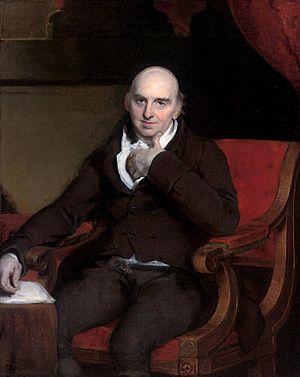William Morgan (actuary) facts for kids
William Morgan (born May 26, 1750 – died May 4, 1833) was a British doctor, scientist, and statistician. He is often called the "father of modern actuarial science". An actuary is someone who uses math to figure out risks, especially for things like insurance. Morgan was also the first to write about a special kind of "invisible light" made when electricity goes through a glass tube with most of the air taken out. This was like an early version of an X-ray machine!
Contents
Early Life and Career
William Morgan was born in a town called Bridgend in Wales. His father was a doctor, and his uncle was a famous thinker named Richard Price. When he was 18, William started studying medicine at a hospital in London. He also worked as an apothecary (like a pharmacist) to help pay for his studies.
After a year, he went back home to work with his father. But his father's patients didn't really like him. They thought he was too young and didn't have enough experience. Also, William had a physical difference with his foot, which some patients found difficult.
After his father passed away, William decided to change careers. In 1774, his uncle Richard Price suggested he apply for a job at the The Equitable Life Assurance Society. This was a very important company that helped people plan for their future, like with life insurance.
Becoming an Actuary
William started as an Assistant Actuary. An actuary uses math to calculate risks and plan for future financial events, especially for insurance companies. Just a year later, in 1775, he became the main Actuary. He worked there for 56 years, until he was 80 years old!
During his long career, William Morgan helped create the rules and methods for the actuarial profession. In fact, the word "actuarial" became linked to this job because of his important role at the company. He made sure that insurance companies could be fair and reliable.
Scientific Discoveries
William Morgan was also very interested in science. A family friend, Joseph Priestley (who discovered oxygen!), encouraged him to do experiments.
The First X-Ray Tube
One of Morgan's most exciting discoveries was about "invisible light." He was the first person to write down what happened when he passed an electric current through a glass tube that had most of the air removed (a "partly evacuated" tube). He saw a strange, invisible light being produced. This was a very early step towards what we now know as X-rays! His work helped other scientists later develop the X-ray machine, which is so important in medicine today.
Awards and Recognition
In 1789, William Morgan won a very important award called the Copley Medal. This medal is given by the Royal Society for amazing scientific achievements. He won it for his two papers about how to calculate the value of things like pensions and how long people might live, which is a big part of actuarial science.
A year later, he was made a Fellow of the Royal Society. This is a great honor for scientists in Britain.
Later Life and Legacy
Later in his life, through his uncle Richard Price, William Morgan became friends with some important political thinkers of his time. He died in 1833 and left behind a huge legacy in both the world of insurance and early science.
Publications
William Morgan wrote several important books and papers. These helped to explain and develop the field of actuarial science:
- The Doctrine of Annuities and Assurances on Lives and Survivorships (1779)
- Nine Addresses to the General Court of the Equitable Society Covering the Years 1793 to 1830 (1833)
Images for kids



